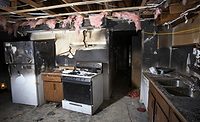Fire Restoration Particulates: Hazards and Solutions




I received a call the other day on a subject that is of increasing concern in the fire restoration workplace. A restoration contractor was concerned about removing particle contaminants on fire losses to prevent their progressive release into respirable air over time, along with a potential for adverse health effects for occupants and workers who may have prolonged exposure.
The fire cycle (combustible components, oxygen, ignition source) produces many hundreds of chemicals in a damaged home or business. Typically, these combustion pollutants fall into two broad categories: oxides of nitrogen from burning organic components, and chlorine dioxide from burning synthetics. Also contained in most combustion soot are polycyclic aromatic hydrocarbons (PAHs), which are suspect carcinogens. Therefore, it stands to reason that proper restoration of smoke-damaged structural materials and contents is of significant importance.
According to the Stanford Research Institute, combustion particles range in size from 0.1 to 4 microns, with environmental tobacco smoke (ETC) being much smaller (0.01-1 micron). By way of comparison, an average human hair is about 75 microns in diameter. To lend perspective to the importance of physical smoke removal, while one-to-four-micron particles settle out of air in a matter of minutes or hours, anything smaller than one micron may remain suspended in respirable air indefinitely.
Human bronchial passages contain ciliated surfaces designed to capture particles down to the 10-micron range, and push them back into the throat where they are swallowed and eliminated through the digestive system. Anything smaller than 10 microns has the potential to penetrate deeper into tender lung tissues where they encounter the alveoli. The alveoli are small sacks in lung tissues that remove oxygen from air in the lungs and transfer it into the bloodstream to oxygenate muscles and organs. At best, smoke particles <10 microns can irritate the alveoli. At worst, they may cause permanent scaring and diminished lung capacity, depending on the amount respired.
With the above considerations in mind, there are several recommended phases for resolving fire contamination, and corresponding potential health effects, by fire restorers:
1. Ventilation: The first phase begins with airing out the structure with positive ventilation - assuming reasonable weather conditions (i.e., heat, cold, humidity, etc.) in the geographical area. Obviously, extremes of heat and cold present occupant comfort limitations in occupied structures, and certainly freezing weather can damage water-bearing appliances or plumbing. Excess humidity from outside, when combined with combustion smoke, only accelerates the formation of acid residues, and extremes of heat and cold have an adverse impact on occupants and workers.
2. Isolation: Where a building has experienced a partial fire loss, it may be prudent to initiate OSHA-mandated engineering controls, such as isolation barriers or even containment with polyethylene sheeting where appropriate.
3. Air Management: Another engineering control on partial losses may involve controlled air management in much the same manner as would be appropriate during mold or sewage remediation (fungal or bacterial contamination). Of course, this assumes that the building can be contained and doesn’t have gaping holes in the roof or burned out windows or doors.
4. PPE: Once OSHA-mandated engineering controls are in place, where possible, the second line of defense against particle contaminants is personal protective equipment (PPE). This may include chemical-resistant gloves, goggles, respirators and even protective clothing. The protection afforded by N-95 respirators is marginal, especially where 0.1-4 micron particles are concerned (ref. Appendix B, IICRC S520); therefore, I specifically recommend tight-fitting face pieces with HEPA filters worn by medically evaluated and fit-tested persons, at a minimum. For even better protection, use a full-face respirator or a powered air-supplied particulate respirator (PAPR) for maximum protection.
5. HEPA Filtration: High efficiency particulate air (HEPA) filters on air filtration equipment is appropriate during fire restoration to capture 99.97% of particles at 0.3 microns. This equipment may be set up initially in areas where extensive or prolonged work (e.g., pack out), or demolition is ongoing. It is essential when demolition of hazardous materials (HAZMAT; lead, asbestos containing materials) is suspected.
6. HEPA Vacuuming: While ventilation or HEPA filtration may help in removing particulates from the air, HEPA vacuuming prior to detergent cleaning is appropriate to capture and remove fine particles from surfaces before they can be suspended in respirable air. HEPA vacuuming also removes fine particles from cracks and crevices where it may not be possible to reach them with wet cleaning. It is particularly important to attend to the interior surfaces of HVAC ductwork and mechanical components, which will be circulating respirable air on a continuing basis.
7. HAZMAT Abatement: In older homes where demolition of fire-damaged structural components is necessary and where HAZMAT, such as lead or asbestos is present or suspected, following the implementation of engineering controls, including containment and positive air management, protected abatement workers usually are required to use adequate wetting during demolition followed by HEPA vacuum cleaning techniques. Unless properly trained, certified and licensed in HAZMAT abatement and disposal, it may be best to hire subcontract personnel to perform this important task.
8. Cleaning: Detergent wiping, while not an efficient method for removing particulates, aids in restoring surfaces to a visually acceptable pre-loss condition, where practical.
I hope this helps to shed some light on the question on fire particle contamination that restoration contractors raise. Certainly if anyone has further questions, I would be glad to address them as possible.
Looking for a reprint of this article?
From high-res PDFs to custom plaques, order your copy today!






